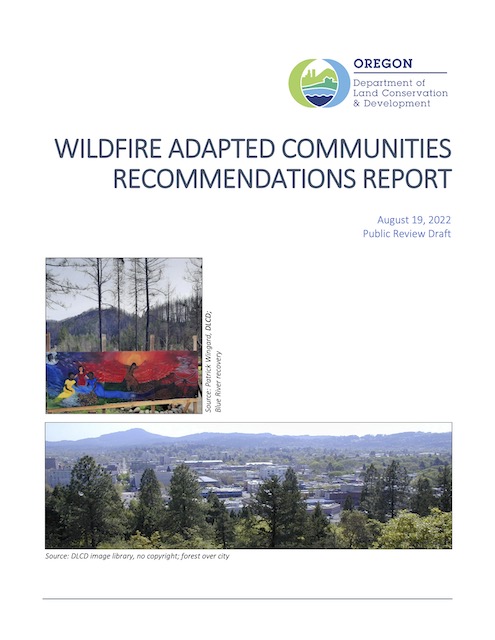Fed by high winds, a wildfire about 50 miles from Antiplanner headquarters in Camp Sherman blew up on Sunday, burning 34,000 acres in a few hours. Meanwhile, Oregon’s Land Conservation & Development Commission (LCDC) is seeking comments on a report it has prepared on “wildfire adapted communities.”
 Click image to download a copy of this report (2.9-MB).
Click image to download a copy of this report (2.9-MB).
The report says little about density other than to suggest that structures be clustered “in areas of lowest risk.” Since the only places in Oregon that are naturally at low risk of wildfire are underwater, this suggests that no “clustering” of development makes sense.
But it is possible to protect existing cities and urban areas by putting a defensible buffer around them. Because high winds can blow fire brands for several miles, such a buffer should be at least five miles wide. It should have minimal flammable vegetation: ordinary forests or grasslands need not apply.
Development can be allowed in this buffer strip so long as it follows an important rule: structures should be at least 100 to 140 feet apart. As residents of Boulder County, Colorado discovered last December, when structures are built more closely together, if one catches fire, the radiant heat it emits will ignite nearby structures.
Currently, about 1.3 percent of the state is urban with small lots that are at high risk from fire, and about 1 percent is “rural residential” with 5- to 10-acre lot sizes. Such lot sizes are too big to provide a buffer since residents will have an incentive to make only the land around their home, probably around a half acre, defensible.
Thus, the most efficient way to construct a wildfire buffer will be to zone a five-mile strip around all cities and urban areas for half-acre to one-acre lots and require that any housing built on such lots be built and maintained in a defensible condition. This will, incidentally, allow construction of hundreds of thousands of new homes, thus alleviating Oregon’s housing shortage.
Comments on the report are due on Friday. I’ve prepared a draft of my comments that I’ll submit then. If you have any suggestions for improving them, let me know.








How about high-rise apartments and condominiums? I haven’t heard much about wildfires in Manhattan or the Chicago Loop.
Perhaps the deep-pockets federal government should quit back-stopping state and local governments that insist on allowing development in dry forests and floodplains.
Or …. build your house out of less flammable shit?
FIRE, has been a part of natural ecology of these regions for thousands of years. Don’t move to a place that has seasonal droughts and fires…. We suppressed fire for over a century and turned the forests of the US west into an insect infested, weed choked, firey tinder box…. The 1988 Yellowstone fire and the reintroduction of wolves, were the ultimate experiment that showcased nature doesn’t really need human management.
water usage has also exacerbated the fire problem. For the last 120 years, the big cities and agriculture business have pulled water from the Colorado river, Sierra Nevada mountains and sub surface wells and springs which have been tapped to accommodate domestic water consumption so LA County residents and suburbanites can have jungle plants in a xeric climate. Combine a drastic reduction in the natural ground water, the replacement of native vegetation with weedy, invasives (and sometimes oil rich plants like Eucalyptus) is a recipe for disaster. So the subsurface water has been depleted; California’s forests have lost significant ground water; soil moisture has heavily declined.
BUILD DESALINATION PLANTS build nuclear plants to run them..at night, load level low power demand by producing water and pumping where its needed…..regenerate ground water, support agriculture. Whatever
DESALINATION costs have declined 90% in 40 years.
Nuclear cost of construction can be amortized thru water production. Nevada and Arizona eschew nuclear because of water demand. That’s changed since Europe and China as well as some US states have invested in air cooled power plants. Nuclear can be air cooled…..
rovingbroker,
Most high-rise apartments and condos are surrounded by pavement, making them the perfect defensible space. Doesn’t mean everyone wants to live in them or that there is any city in the world that consists exclusively of high-rise apartments and condos, so the question is how to protect the structures at the edge of urban areas.
Hmmmmm. build your house out of less flammable shit?
Antiplanner: Exactly. An alternative would be to move everyone to Chicago or St. Louis or Phoenix.
There was a time when insurance rates (or inability to get insurance) would prevent people from making bad decisions about siting and construction but apparently, they expect “the government” to bail them out … assuming they survive the conflagration.
Cities don’t have fires….
As. Science fiction fan I’ve always thought Colorado, switzerland….places with mountains would build mountain cities… tiered cities like those in Europe.
In our case bigger. Or integrated into the slope if the landscape.
https://i.pinimg.com/originals/d7/db/cc/d7dbcca5afcd8b4e1ffafc304233f980.jpg
Headwaters Economics has done a couple of fire mitigation plans that might be useful to reference. The big point which you already not is lot size. The idea of very large lot sizes runs directly contrary to the needs for fire mitigation. Also I would mention the role of logging, roads, and fire mitigation.